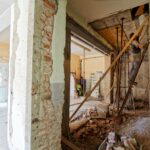VA Renovation Loans cater to service members and qualifying relatives. They are designed to help you build or purchase a home and make improvements without doling out a hefty sum of cash. In fact, they don’t require a down payment, which makes this option attractive to those who qualify.
What is a VA Renovation Loan?
Backed by the Department of Veteran Affairs, VA Renovation Loans lets you roll renovation costs into your mortgage if you purchase a new home. You can also refinance your existing loan and roll improvement costs into a new VA Renovation Loan.
Loan amounts are determined by the home’s after-renovation value or what it’s expected to be worth once improvements are completed. Generally, you can borrow up to $50,000 to cover eligible repairs, and the total loan amount is limited to $548,250.
How Do VA Renovation Loans Work?
Here’s a step-by-step breakdown of how VA Renovation Loans work:
- Step 1: Obtain a certificate of eligibility (COE) to confirm your eligibility for a VA loan.
- Step 2: Compile a list of home improvements you’d like to complete.
- Step 3: Shop around for a lender that offers VA Renovation loans and get pre-approved.
- Step 4: Research VA-approved contractors and get quotes for your home improvement project.
- Step 5: Connect with your lender to schedule a home appraisal. The VA appraiser will assess the home to determine the projected or as-completed value following renovations.
- Step 6: Attend closing and sign the final loan documents. The lender will also deposit the funds for renovation into an escrow account and draw against it to pay contractors as the project progresses.
- Step 7: A VA appraiser performs a final inspection of the property once the project is complete to ensure it meets VA’s property standards.
Before applying for a VA Renovation Loan, you should be mindful of the benefits and drawbacks.
Advantages of VA Renovation Loans
These loans offer the following benefits:
- Borrow up to 100 percent of the after-renovation value
- No minimum credit score.
- No down payment requirement.
- No mortgage insurance requirement.
Disadvantages of VA Renovation Loans
Unfortunately, there are drawbacks to consider:
- Not all repairs and improvements are eligible for funding.
- You’re required to use a VA-registered contractor and appraiser.
- The lending process is complex.
How to Qualify For a VA Rehab Loan
VA renovation loans are limited to individuals who meet these criteria:
- Are active service members, veterans, or surviving spouses of a former service member
- Have a credit score of at least 620
- Have a debt-to-income ratio of no more than 50 percent (unless an approval is received by the Automated Underwriting System (AUS)
Before you can close on a VA Renovation Loan, the lender will likely require the following:
- Two years of W-2 forms
- Two most recent pay stubs
- Two months of bank statements
- Two months of statements for all other asset accounts (i.e., retirement and investments)
- Proof of homeowners insurance
- Title report and insurance
- A formal costs estimated from a VA-registered contractor
- A Certificate of Eligibility (which confirms your status as a veteran)
Other Loans to Finance Home Improvement Projects
Not quite sold on the idea of getting a VA Renovation Loan to fund your home improvements? Several other options may be available to you.
Home Equity Loans
A home equity loan is a fixed-rate product that allows you to borrow between 80 and 90 percent of your current home value (minus the amount you owe on your existing mortgage). Funds are disbursed in a lump sum, and you’ll make fixed monthly payments over a repayment period of five to 20 years. The term you receive depends on the lender.
These loans are commonly used by homeowners with a substantial amount of equity in their homes. But suppose you’ve recently moved and have little to no equity. In that case, a home equity loan likely isn’t a viable financing solution for you.
Home Equity Lines of Credit
You can also tap into your home’s equity with a HELOC. However, funds are available through a line of credit with a draw period of five to 10 years. You’re permitted to withdraw the amount you need at any time during this window, and you’ll make interest-only payments until the draw period ends.
The repayment period is usually 10 to 20 years. You can expect a variable interest rate, which means payment amounts could change over time.
Similar to home equity loans, HELOCs aren’t suitable for funding home improvements if you have minimal equity in your home.
Personal Loans
Often marketed as home improvement loans, personal loans are unsecured products that cater to homeowners seeking funding for renovations. They’re appealing because your home is not used as collateral to secure the loan.
Personal loans often come with relatively high-interest rates and a brief repayment period, which is a significant drawback. Monthly payments will likely be higher and could result in financial distress. There’s also a chance you won’t get approved for the amount you need.
Fannie Mae HomeStyle® Renovation Mortgages
You can borrow up to 95 percent of your home’s after-renovation value with this loan. Unfortunately, you’ll have to pay private mortgage insurance if your down payment is less than 20 percent. And you’ll have to refinance your existing mortgage, which means the new rate could be higher.
FHA 203(k) Loans
Backed by the federal government, FHA 203(k) loans are designed for borrowers with less-than-perfect credit. You could be eligible for up to 96.5 percent of your home’s future value, but FHA mortgage insurance is required for the life of the loan.







